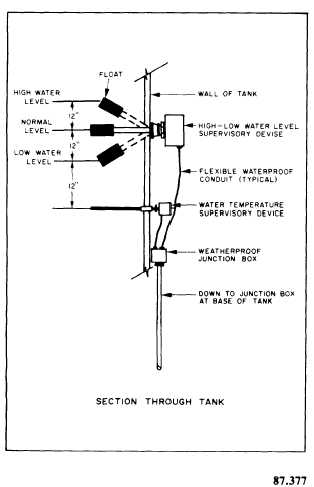of normal limits. Figure 8-29 shows a typical high- low water level supervisory device installed in a sprinkler system reservoir.
A pressure-actuated level indicator is physically very similar to the bellows-operated pressure switches used for water-flow detection (fig. 8-21). As the water level changes in a reservoir, the water pressure at the supervisory switch also changes. The switch can be adjusted to actuate when pressure indicates a low water level or a high water level. This device is generally installed in the piping near the bottom of the reservoir.
Electronic level indicators may also be found in some systems. These indicators read the conductivity of water to cause an electrical signal. These devices are most frequently used to sense high water levels. They are not commonly used in fire protection systems.
Temperature supervisory devices are used to prevent water freezing in fire protection systems.

Figure 8-29. - Installation of water level and water temperature supervisory devices.
Utilitiesmen will most commonly work with low water temperature indicators. These are usually sealed, factory-set thermostats and may be installed in system pipe or reservoirs. The most frequent low temperature setting is 40F. Figure 8-29 shows a low water temperature indicator installed in a system reservoir.
You may find other supervisory devices in use. They will usually be specifically designed for a particular system. The principles of operation are generally the same as those already discussed. Physical mounting provisions or other details may vary. Refer to NAVFAC MO-117, manufacturer's manuals, and NFPA #13 for more complete information, when you must install or maintain these devices.
WATER SUPPLY REQUIREMENTS
Water supplies that serve sprinkler systems must be adequate and reliable. To determine the amount of water necessary for a sprinkler system, the rate of flow and pressure needed for effective performance must be known. If additional fire hose streams from outside the building will be required, these should also be included. The combined water needed for all fire-fighting equipment is known as the fire flow demand.
An adequate system can deliver the required fire flow for a specified time with normal water consumption at the maximum rate. To be reliable, the system must also be able to deliver the fire flow demand under certain emergency conditions, such as when a supply main or pump is out of service. The desired reliability of the system depends upon the nature of the protected structure (people, property, or mission). Water may be supplied by public or base sources, water tanks, or fire pumps.
For specific information regarding the fire flow demands of sprinkler systems, refer to NFPA #13, chapters 2, 7, and 8. These chapters will give you the information required for the sizing of each particular type of sprinkler system hazard based on residual pressure, acceptable flow rates, and duration times.
INSPECTION, TESTING, AND MAINTENANCE REQUIREMENTS
Sprinkler systems, when properly installed, are an effective means of fire protection for life and property. To make sure these systems are reliable,
Continue Reading